Samsung CLP-770ND Review
Samsung CLP-770ND
This premium colour laser printer promises speed, quality and flexibility. Can it deliver them?

Verdict
Key Specifications
- Review Price: £578.19
Colour laser printers start at around £150, but climb rapidly in price as you move from the SOHO to the workgroup markets. You pay for extra speed, flexibility in paper handling and the robustness to handle higher workloads. When you get to £500 to £600 area, Samsung’s CLP-770ND is on the menu, discounted from a fairly silly list price of £1,449.
This is a monolithic machine, with a big, square-cut case, chamfered off at the front to create space for a control panel and with a slightly strange arrangement of main 500-sheet paper tray and fold-down, 100-sheet multipurpose tray. As you fold down the multipurpose tray, it opens a slot in the front of the machine for the paper to feed through.
You can fit a couple of extra, 500-sheet paper trays as options, so the total feed capacity is 1,600 sheets, which should keep even a busy office going for a fair while. Paper feeds out to an indentation in the top cover of the machine but, even with its substantial dimensions, you still have to raise a support flap to stop pages falling off the back.
The control panel is simple, but effective, with a 4-line by 16-character, backlit LCD display showing all status messages. The display is fully bitmapped, so can show graphics as well as text. Two buttons set beside the display select menu options and back up the menu tree, and there’s a four-way ring of navigation buttons, with a large OK button in the centre. To the right are Cancel and Power buttons.
At the rear of the right-hand side of the machine are sockets for USB and Ethernet, which is not as neat a location as putting them on the back panel.
Physical set up involves inserting the four drum and toner cartridges, one for each colour. The transfer belt engages in the front cover of the printer and the fuser is reached through a smaller cover on the top.
Support software is fairly standard, with monitoring and supplies applets, as well as drivers. Both Postscript Level 3 and PCL 6 are supported in emulation and the machine can be driven from Windows, OS X and various Linux distributions.
Samsung rates the CLP-770ND at 32ppm for both black and colour print, but under our tests it didn’t come close to that speed. On short documents, such as our five-page black text print, it achieved 12.5ppm and was slightly faster on the black text and colour graphics document – five copies of the same page – at 15ppm. The colour document was quicker largely because only a single page has to be rasterised.
Increasing the number of pages to 20 on a black text test also increased the print speed to 23.5ppm, still some way short of the quoted speed. Printing duplex, which is a standard option, was comparatively quick, with the same 20-side document printing on 10 sheets in 1:31, a speed of 13.19 sides per minute.
The printer produces good quality copy with well-formed black text, showing no rough edges or toner spatter to distract from a high contrast, black and white document. Colour business graphics are also well reproduced, with strong, solid colours and excellent black text registration over colour.
Photo reproduction, from what Samsung claims is an enhanced resolution of 9,600 x 600dpi, gives plenty of detail and colours are quite well reproduced to. There’s detail in darker, shadowed areas, which many lasers don’t pick up, and a wider colour gamut than from many of its rivals.
There are two consumables to consider in the CLP-770ND: the four drum and toner cartridges, each of which is rated at 7,000 pages (though the machine is supplied with 3,500-page starter cartridges) and a 50,000-page transfer belt. Adding up the costs of all these gives a black page cost of 2.13p and a colour cost of 7.33p.
Both these figures are pretty good with, for comparison, the costs for running the £412 Canon i-SENSYS LBP7200Cdn coming out at 4.86p and 19.14p. Although you can get low running costs, most of these come from printers with much higher purchase prices. A 7,000 page cartridge for £75 is a pretty good price, these days.
Verdict
This is a good, solid colour laser printer for use in busy environments, such as large workgroups or small departments, but there’s not a lot to get excited about. It’s not unduly quick or filled with the latest innovations. There’s no USB port on the front panel, for example, or password-protected, walk-up print facility.
Where it does achieve, though, is in the most important areas for any printer. It gives good quality prints, from straight black text through to full-colour photos, which a lot of lasers struggle with and it’s not expensive to run, given its asking price. Overall, you get what counts in this £570 colour heavyweight.


Trusted Score
Score in detail
-
Print Speed 7
-
Features 7
-
Value 9
-
Print Quality 9
Features
| Networking | Fast Ethernet |
Printing
| Duplex | Automatic |
| Paper Size | Letter, Custom Size |
| Sheet Capacity | 600 sheets |
| Rated Black Speed (Images per minute) | 33 ppmipm |
| Rated Colour Speed (Images per minute) | 33 ppmipm |

